International Marketing: Why Economic Environment Matters Most
VerifiedAdded on 2023/06/14
|6
|1435
|486
Essay
AI Summary
This essay argues that the economic environment is the most important consideration for enterprises engaging in international marketing. It discusses the significance of GDP growth, per capita disposable income, and exchange rates, highlighting how these factors influence consumer buying power and business expansion. Counterarguments related to the importance of political, cultural, and religious factors are addressed with refutations emphasizing the feasibility of gaining local knowledge and forming strategic partnerships. The essay concludes that understanding and adapting to the economic dynamics of a host country is crucial for maximizing profit and achieving success in international markets. Desklib provides students with access to a wide range of resources, including solved assignments and past papers, to support their academic endeavors.
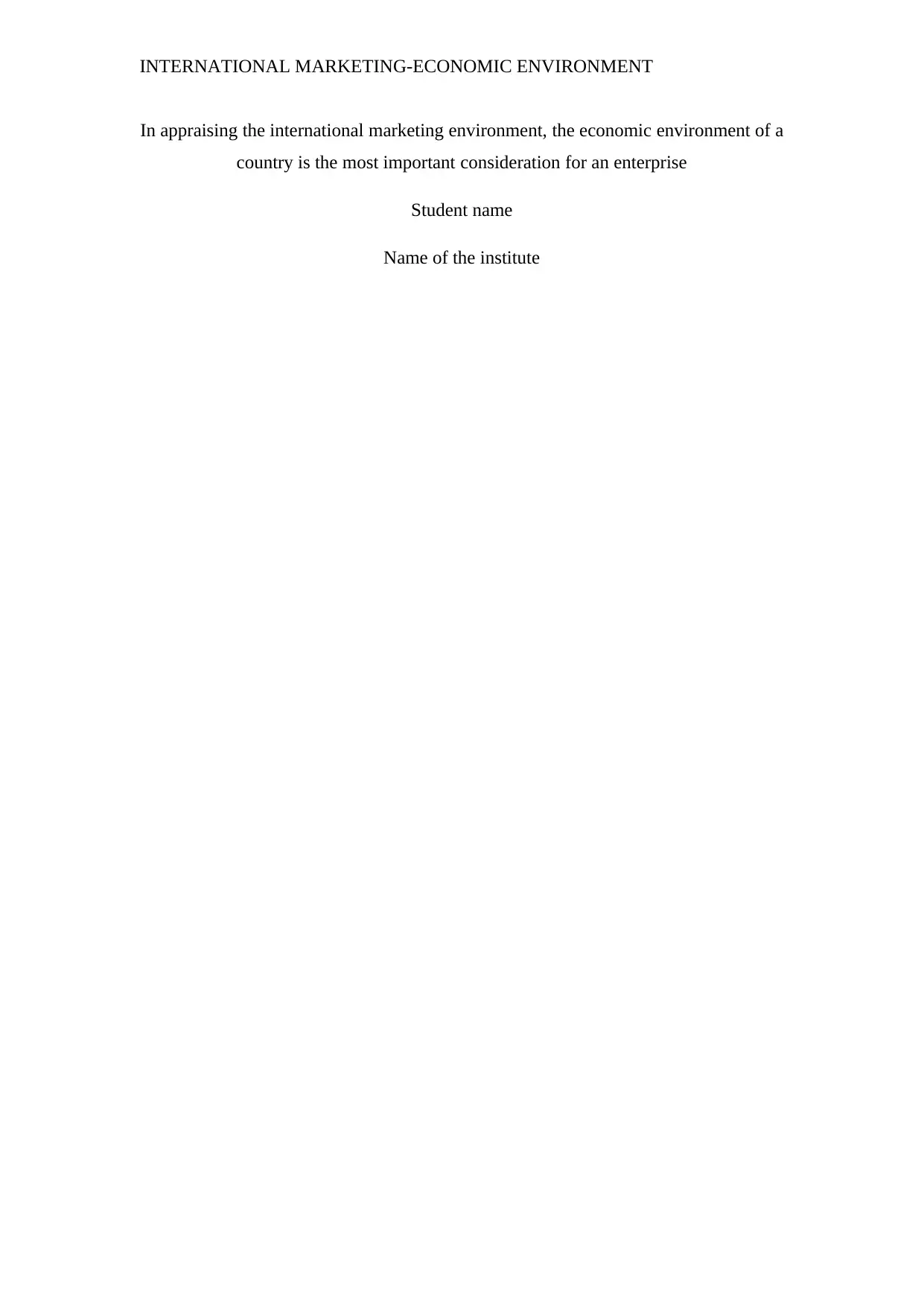
INTERNATIONAL MARKETING-ECONOMIC ENVIRONMENT
In appraising the international marketing environment, the economic environment of a
country is the most important consideration for an enterprise
Student name
Name of the institute
In appraising the international marketing environment, the economic environment of a
country is the most important consideration for an enterprise
Student name
Name of the institute
Paraphrase This Document
Need a fresh take? Get an instant paraphrase of this document with our AI Paraphraser
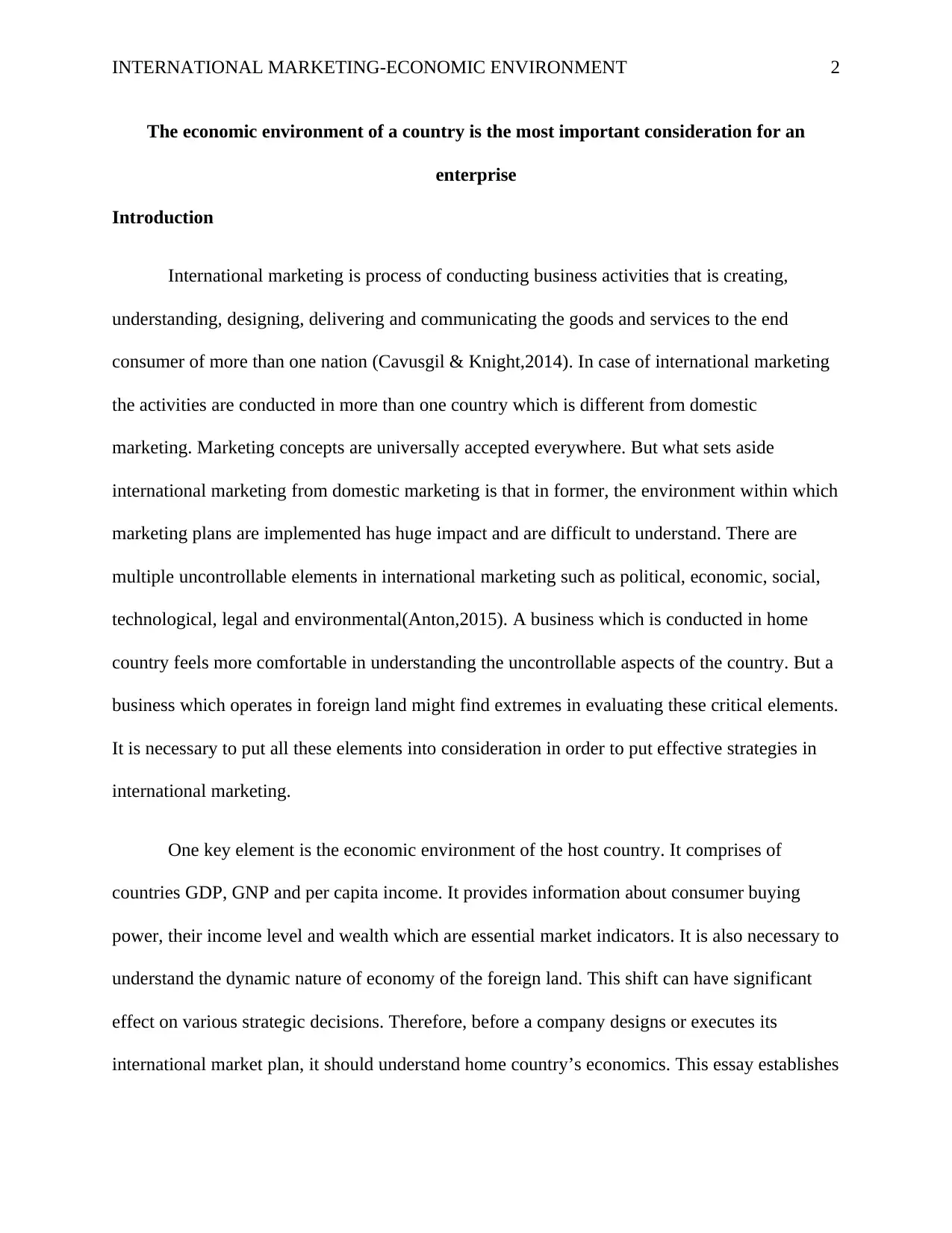
INTERNATIONAL MARKETING-ECONOMIC ENVIRONMENT
The economic environment of a country is the most important consideration for an
enterprise
Introduction
International marketing is process of conducting business activities that is creating,
understanding, designing, delivering and communicating the goods and services to the end
consumer of more than one nation (Cavusgil & Knight,2014). In case of international marketing
the activities are conducted in more than one country which is different from domestic
marketing. Marketing concepts are universally accepted everywhere. But what sets aside
international marketing from domestic marketing is that in former, the environment within which
marketing plans are implemented has huge impact and are difficult to understand. There are
multiple uncontrollable elements in international marketing such as political, economic, social,
technological, legal and environmental(Anton,2015). A business which is conducted in home
country feels more comfortable in understanding the uncontrollable aspects of the country. But a
business which operates in foreign land might find extremes in evaluating these critical elements.
It is necessary to put all these elements into consideration in order to put effective strategies in
international marketing.
One key element is the economic environment of the host country. It comprises of
countries GDP, GNP and per capita income. It provides information about consumer buying
power, their income level and wealth which are essential market indicators. It is also necessary to
understand the dynamic nature of economy of the foreign land. This shift can have significant
effect on various strategic decisions. Therefore, before a company designs or executes its
international market plan, it should understand home country’s economics. This essay establishes
2
The economic environment of a country is the most important consideration for an
enterprise
Introduction
International marketing is process of conducting business activities that is creating,
understanding, designing, delivering and communicating the goods and services to the end
consumer of more than one nation (Cavusgil & Knight,2014). In case of international marketing
the activities are conducted in more than one country which is different from domestic
marketing. Marketing concepts are universally accepted everywhere. But what sets aside
international marketing from domestic marketing is that in former, the environment within which
marketing plans are implemented has huge impact and are difficult to understand. There are
multiple uncontrollable elements in international marketing such as political, economic, social,
technological, legal and environmental(Anton,2015). A business which is conducted in home
country feels more comfortable in understanding the uncontrollable aspects of the country. But a
business which operates in foreign land might find extremes in evaluating these critical elements.
It is necessary to put all these elements into consideration in order to put effective strategies in
international marketing.
One key element is the economic environment of the host country. It comprises of
countries GDP, GNP and per capita income. It provides information about consumer buying
power, their income level and wealth which are essential market indicators. It is also necessary to
understand the dynamic nature of economy of the foreign land. This shift can have significant
effect on various strategic decisions. Therefore, before a company designs or executes its
international market plan, it should understand home country’s economics. This essay establishes
2
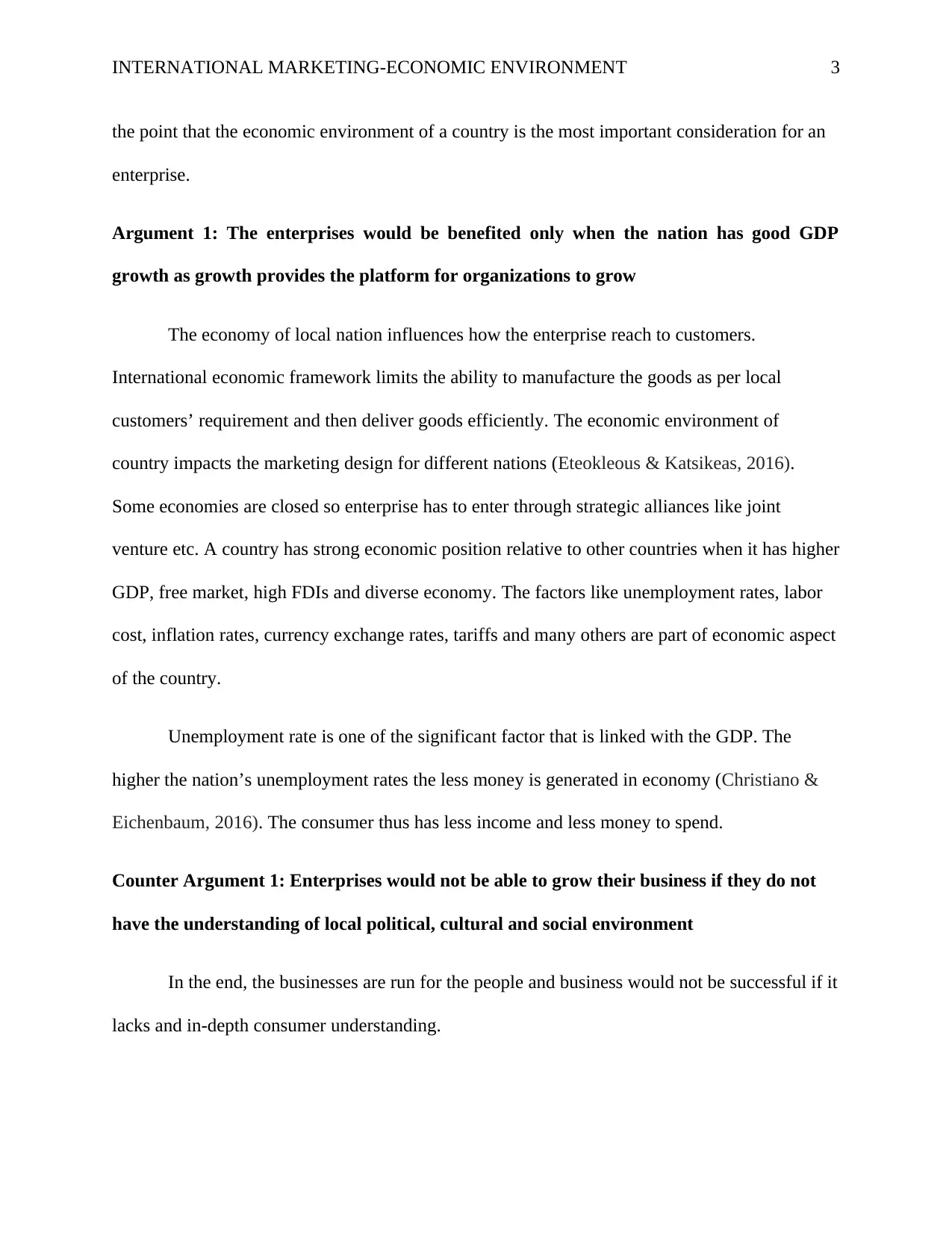
INTERNATIONAL MARKETING-ECONOMIC ENVIRONMENT
the point that the economic environment of a country is the most important consideration for an
enterprise.
Argument 1: The enterprises would be benefited only when the nation has good GDP
growth as growth provides the platform for organizations to grow
The economy of local nation influences how the enterprise reach to customers.
International economic framework limits the ability to manufacture the goods as per local
customers’ requirement and then deliver goods efficiently. The economic environment of
country impacts the marketing design for different nations (Eteokleous & Katsikeas, 2016).
Some economies are closed so enterprise has to enter through strategic alliances like joint
venture etc. A country has strong economic position relative to other countries when it has higher
GDP, free market, high FDIs and diverse economy. The factors like unemployment rates, labor
cost, inflation rates, currency exchange rates, tariffs and many others are part of economic aspect
of the country.
Unemployment rate is one of the significant factor that is linked with the GDP. The
higher the nation’s unemployment rates the less money is generated in economy (Christiano &
Eichenbaum, 2016). The consumer thus has less income and less money to spend.
Counter Argument 1: Enterprises would not be able to grow their business if they do not
have the understanding of local political, cultural and social environment
In the end, the businesses are run for the people and business would not be successful if it
lacks and in-depth consumer understanding.
3
the point that the economic environment of a country is the most important consideration for an
enterprise.
Argument 1: The enterprises would be benefited only when the nation has good GDP
growth as growth provides the platform for organizations to grow
The economy of local nation influences how the enterprise reach to customers.
International economic framework limits the ability to manufacture the goods as per local
customers’ requirement and then deliver goods efficiently. The economic environment of
country impacts the marketing design for different nations (Eteokleous & Katsikeas, 2016).
Some economies are closed so enterprise has to enter through strategic alliances like joint
venture etc. A country has strong economic position relative to other countries when it has higher
GDP, free market, high FDIs and diverse economy. The factors like unemployment rates, labor
cost, inflation rates, currency exchange rates, tariffs and many others are part of economic aspect
of the country.
Unemployment rate is one of the significant factor that is linked with the GDP. The
higher the nation’s unemployment rates the less money is generated in economy (Christiano &
Eichenbaum, 2016). The consumer thus has less income and less money to spend.
Counter Argument 1: Enterprises would not be able to grow their business if they do not
have the understanding of local political, cultural and social environment
In the end, the businesses are run for the people and business would not be successful if it
lacks and in-depth consumer understanding.
3
⊘ This is a preview!⊘
Do you want full access?
Subscribe today to unlock all pages.

Trusted by 1+ million students worldwide
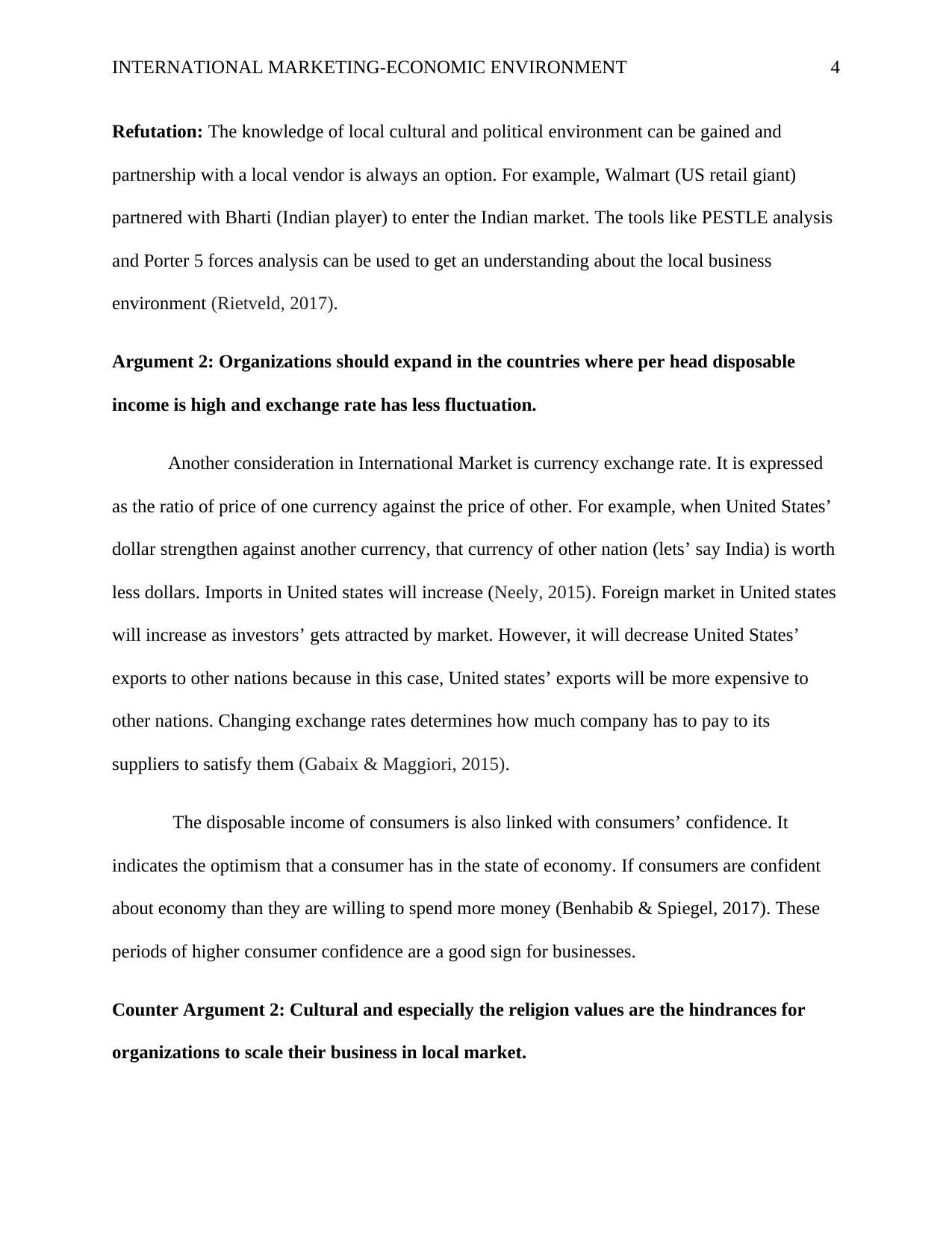
INTERNATIONAL MARKETING-ECONOMIC ENVIRONMENT
Refutation: The knowledge of local cultural and political environment can be gained and
partnership with a local vendor is always an option. For example, Walmart (US retail giant)
partnered with Bharti (Indian player) to enter the Indian market. The tools like PESTLE analysis
and Porter 5 forces analysis can be used to get an understanding about the local business
environment (Rietveld, 2017).
Argument 2: Organizations should expand in the countries where per head disposable
income is high and exchange rate has less fluctuation.
Another consideration in International Market is currency exchange rate. It is expressed
as the ratio of price of one currency against the price of other. For example, when United States’
dollar strengthen against another currency, that currency of other nation (lets’ say India) is worth
less dollars. Imports in United states will increase (Neely, 2015). Foreign market in United states
will increase as investors’ gets attracted by market. However, it will decrease United States’
exports to other nations because in this case, United states’ exports will be more expensive to
other nations. Changing exchange rates determines how much company has to pay to its
suppliers to satisfy them (Gabaix & Maggiori, 2015).
The disposable income of consumers is also linked with consumers’ confidence. It
indicates the optimism that a consumer has in the state of economy. If consumers are confident
about economy than they are willing to spend more money (Benhabib & Spiegel, 2017). These
periods of higher consumer confidence are a good sign for businesses.
Counter Argument 2: Cultural and especially the religion values are the hindrances for
organizations to scale their business in local market.
4
Refutation: The knowledge of local cultural and political environment can be gained and
partnership with a local vendor is always an option. For example, Walmart (US retail giant)
partnered with Bharti (Indian player) to enter the Indian market. The tools like PESTLE analysis
and Porter 5 forces analysis can be used to get an understanding about the local business
environment (Rietveld, 2017).
Argument 2: Organizations should expand in the countries where per head disposable
income is high and exchange rate has less fluctuation.
Another consideration in International Market is currency exchange rate. It is expressed
as the ratio of price of one currency against the price of other. For example, when United States’
dollar strengthen against another currency, that currency of other nation (lets’ say India) is worth
less dollars. Imports in United states will increase (Neely, 2015). Foreign market in United states
will increase as investors’ gets attracted by market. However, it will decrease United States’
exports to other nations because in this case, United states’ exports will be more expensive to
other nations. Changing exchange rates determines how much company has to pay to its
suppliers to satisfy them (Gabaix & Maggiori, 2015).
The disposable income of consumers is also linked with consumers’ confidence. It
indicates the optimism that a consumer has in the state of economy. If consumers are confident
about economy than they are willing to spend more money (Benhabib & Spiegel, 2017). These
periods of higher consumer confidence are a good sign for businesses.
Counter Argument 2: Cultural and especially the religion values are the hindrances for
organizations to scale their business in local market.
4
Paraphrase This Document
Need a fresh take? Get an instant paraphrase of this document with our AI Paraphraser
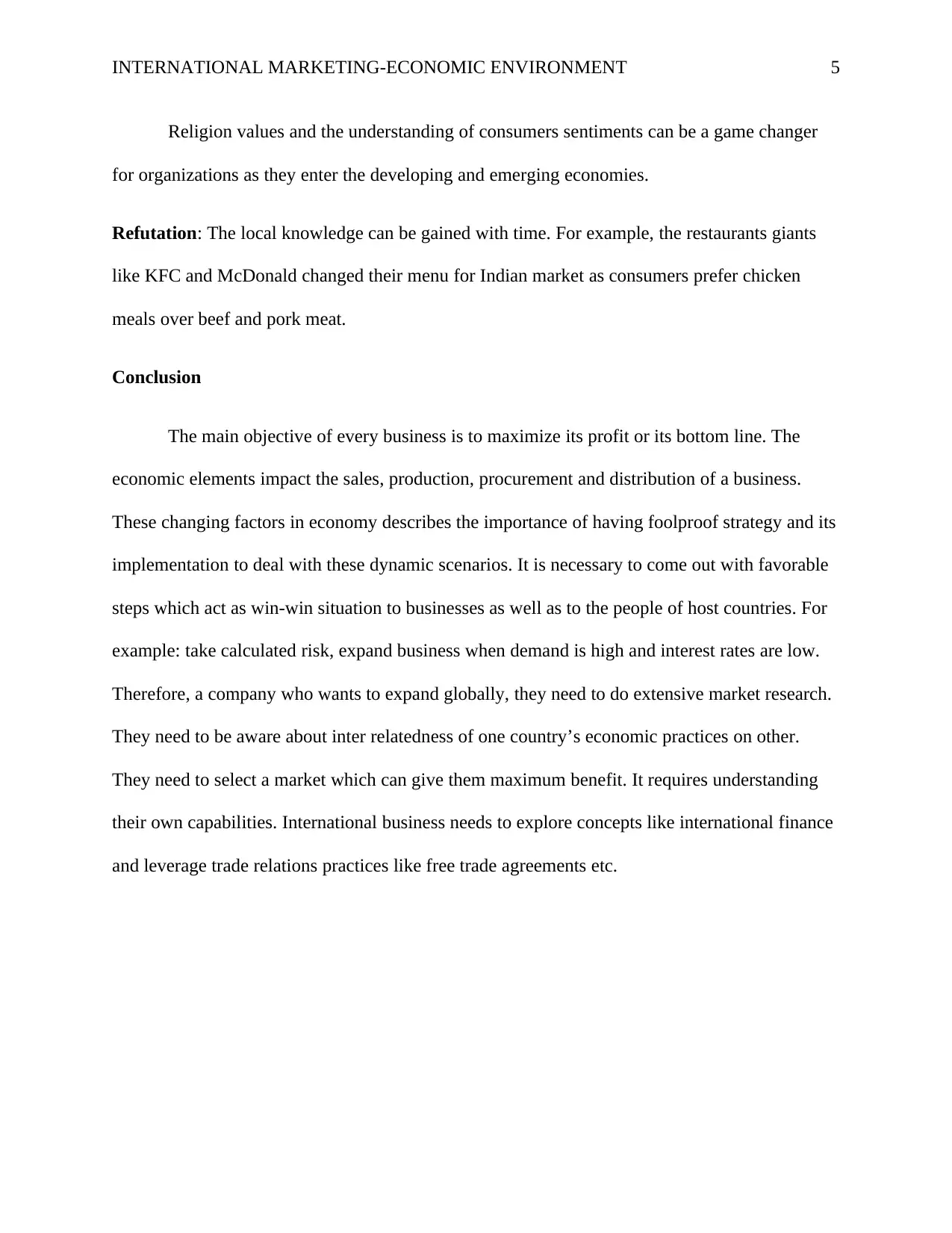
INTERNATIONAL MARKETING-ECONOMIC ENVIRONMENT
Religion values and the understanding of consumers sentiments can be a game changer
for organizations as they enter the developing and emerging economies.
Refutation: The local knowledge can be gained with time. For example, the restaurants giants
like KFC and McDonald changed their menu for Indian market as consumers prefer chicken
meals over beef and pork meat.
Conclusion
The main objective of every business is to maximize its profit or its bottom line. The
economic elements impact the sales, production, procurement and distribution of a business.
These changing factors in economy describes the importance of having foolproof strategy and its
implementation to deal with these dynamic scenarios. It is necessary to come out with favorable
steps which act as win-win situation to businesses as well as to the people of host countries. For
example: take calculated risk, expand business when demand is high and interest rates are low.
Therefore, a company who wants to expand globally, they need to do extensive market research.
They need to be aware about inter relatedness of one country’s economic practices on other.
They need to select a market which can give them maximum benefit. It requires understanding
their own capabilities. International business needs to explore concepts like international finance
and leverage trade relations practices like free trade agreements etc.
5
Religion values and the understanding of consumers sentiments can be a game changer
for organizations as they enter the developing and emerging economies.
Refutation: The local knowledge can be gained with time. For example, the restaurants giants
like KFC and McDonald changed their menu for Indian market as consumers prefer chicken
meals over beef and pork meat.
Conclusion
The main objective of every business is to maximize its profit or its bottom line. The
economic elements impact the sales, production, procurement and distribution of a business.
These changing factors in economy describes the importance of having foolproof strategy and its
implementation to deal with these dynamic scenarios. It is necessary to come out with favorable
steps which act as win-win situation to businesses as well as to the people of host countries. For
example: take calculated risk, expand business when demand is high and interest rates are low.
Therefore, a company who wants to expand globally, they need to do extensive market research.
They need to be aware about inter relatedness of one country’s economic practices on other.
They need to select a market which can give them maximum benefit. It requires understanding
their own capabilities. International business needs to explore concepts like international finance
and leverage trade relations practices like free trade agreements etc.
5

INTERNATIONAL MARKETING-ECONOMIC ENVIRONMENT
References:
Anton, R. (2015). An Integrated Strategy Framework (ISF) for Combining Porter's 5-Forces,
Diamond, PESTEL, and SWOT Analysis.
Benhabib, J., & Spiegel, M. M. (2017). Sentiments and economic activity: Evidence from US
states. The Economic Journal.
Cavusgil, S. T., Knight, G., Riesenberger, J. R., Rammal, H. G., & Rose, E. L. (2014).
International business. Pearson Australia.
Christiano, L. J., Eichenbaum, M. S., & Trabandt, M. (2016). Unemployment and business
cycles. Econometrica, 84(4), 1523-1569.
Eteokleous, P. P., Katsikeas, C. S., & Leonidou, L. C. (2016). Review of research on csr in
international marketing: 1993–2013. In Let’s Get Engaged! Crossing the Threshold of
Marketing’s Engagement Era (pp. 683-684). Springer, Cham.
Gabaix, X., & Maggiori, M. (2015). International liquidity and exchange rate dynamics. The
Quarterly Journal of Economics, 130(3), 1369-1420.
Neely, C. J. (2015). Unconventional monetary policy had large international effects. Journal of
Banking & Finance, 52, 101-111.
Rietveld, P. (2017). Obstacles to openness of border regions in Europe. In Gaining Advantage
from Open Borders (pp. 95-112). Routledge.
6
References:
Anton, R. (2015). An Integrated Strategy Framework (ISF) for Combining Porter's 5-Forces,
Diamond, PESTEL, and SWOT Analysis.
Benhabib, J., & Spiegel, M. M. (2017). Sentiments and economic activity: Evidence from US
states. The Economic Journal.
Cavusgil, S. T., Knight, G., Riesenberger, J. R., Rammal, H. G., & Rose, E. L. (2014).
International business. Pearson Australia.
Christiano, L. J., Eichenbaum, M. S., & Trabandt, M. (2016). Unemployment and business
cycles. Econometrica, 84(4), 1523-1569.
Eteokleous, P. P., Katsikeas, C. S., & Leonidou, L. C. (2016). Review of research on csr in
international marketing: 1993–2013. In Let’s Get Engaged! Crossing the Threshold of
Marketing’s Engagement Era (pp. 683-684). Springer, Cham.
Gabaix, X., & Maggiori, M. (2015). International liquidity and exchange rate dynamics. The
Quarterly Journal of Economics, 130(3), 1369-1420.
Neely, C. J. (2015). Unconventional monetary policy had large international effects. Journal of
Banking & Finance, 52, 101-111.
Rietveld, P. (2017). Obstacles to openness of border regions in Europe. In Gaining Advantage
from Open Borders (pp. 95-112). Routledge.
6
⊘ This is a preview!⊘
Do you want full access?
Subscribe today to unlock all pages.

Trusted by 1+ million students worldwide
1 out of 6
Related Documents
Your All-in-One AI-Powered Toolkit for Academic Success.
+13062052269
info@desklib.com
Available 24*7 on WhatsApp / Email
![[object Object]](/_next/static/media/star-bottom.7253800d.svg)
Unlock your academic potential
Copyright © 2020–2026 A2Z Services. All Rights Reserved. Developed and managed by ZUCOL.




